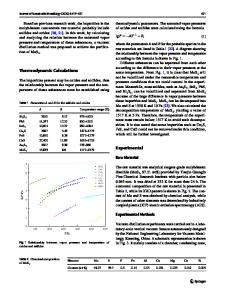Improved Mechanical and Tribological Properties of Bismaleimides Resins by Surface-Functionalized Molybdenum Disulfide
- PDF / 1,432,213 Bytes
- 8 Pages / 595.276 x 790.866 pts Page_size
- 36 Downloads / 335 Views
Improved Mechanical and Tribological Properties of Bismaleimides Resins by Surface‑Functionalized Molybdenum Disulfide Changhu Zhang1 · Yaping He1 · Zhen Liu1 · Gengrong Chang2 · Chunbao Zhao1 Received: 7 August 2020 / Accepted: 14 October 2020 © Springer Science+Business Media, LLC, part of Springer Nature 2020
Abstract In order to improve the mechanical and tribological properties of bismaleimides (BMI), molybdenum disulfide (MoS2) as a filler was surface-functionalized with N-(2-aminoethyl)-3-aminopropyltrimethoxysilane (KH-792) via a hydrolysis process, and the imino and amidogen groups were then introduced onto the surface of MoS2 (NH2-MoS2). The influence of the NH2-MoS2 content on the mechanical, tribological, and thermal properties of BMI resins was studied mainly. The results showed that suitable addition of the N H2-MoS2 could largely enhance the mechanical properties due to the chemical reaction between BMI and NH2-MoS2, decrease the frictional coefficient and wear rate of BMI resins dramatically. The wear mechanism of the BMI resins with the addition of N H2-MoS2 was converted from adhesive wear to abrasive wear, as observed from the wear surface of the materials by scanning electron microscopy (SEM). The thermogravimetric analysis (TGA) showed that the BMI composite with 5 wt% NH2-MoS2 exhibited better thermotolerance, thus inhibiting the adhesive wear during the effective wear, which corresponded to the tribological properties of composites. Keywords Bismaleimides · Siloxane · MoS2 · Tribiological properties · Mechanical properties
1 Introduction Nowadays, low-dimensional materials have drawn great concerns for their remarkable properties, such as good dimensional stability, excellent load capacity, high mechanical properties, etc. [1–3]. Especially, two-dimensional nanoparticles possess special lamellar structure, and the atoms have strong covalent bonds within each layer [4], whilst adjacent layers are bonded by weak van der Waals force, which can be associated with better anti-wear properties, specific ratios and low density [5]. For example, Wu et al. [6, 7] have fabricated hBN or AlN /PTFE composites. In their work, the hBN platelets and aluminum nitride (AlN) nanoparticles were used as hybrid fillers to improve the thermal conductivity of polytetrafluoroethylene (PTFE).
* Changhu Zhang [email protected] 1
College of Chemical Engineering, Xi’an University, Xi’an, People’s Republic of China
The Key Laboratory for Surface Engineering and Remanufacturing in Shaanxi Province, Xi’an 710065, Shaanxi, People’s Republic of China
2
As a kind of two-dimensional nano-particles, molybdenum disulfide (MoS2) not only exhibits the excellent properties mentioned above, but also possesses good economic benefits, abundant resources, and environmental friendliness [8–10]; thus it can be used in many fields including those nanoelectronics [11–13] and photonics, catalysts, tribology etc. [14–16]. However, as a kind of inorganic solids, the MoS2 has relatively inactive basal planes, low
Data Loading...











